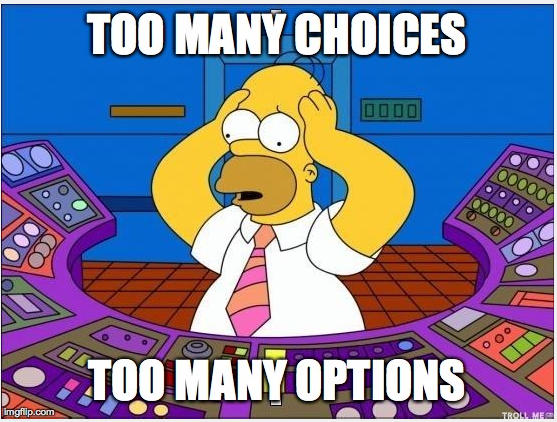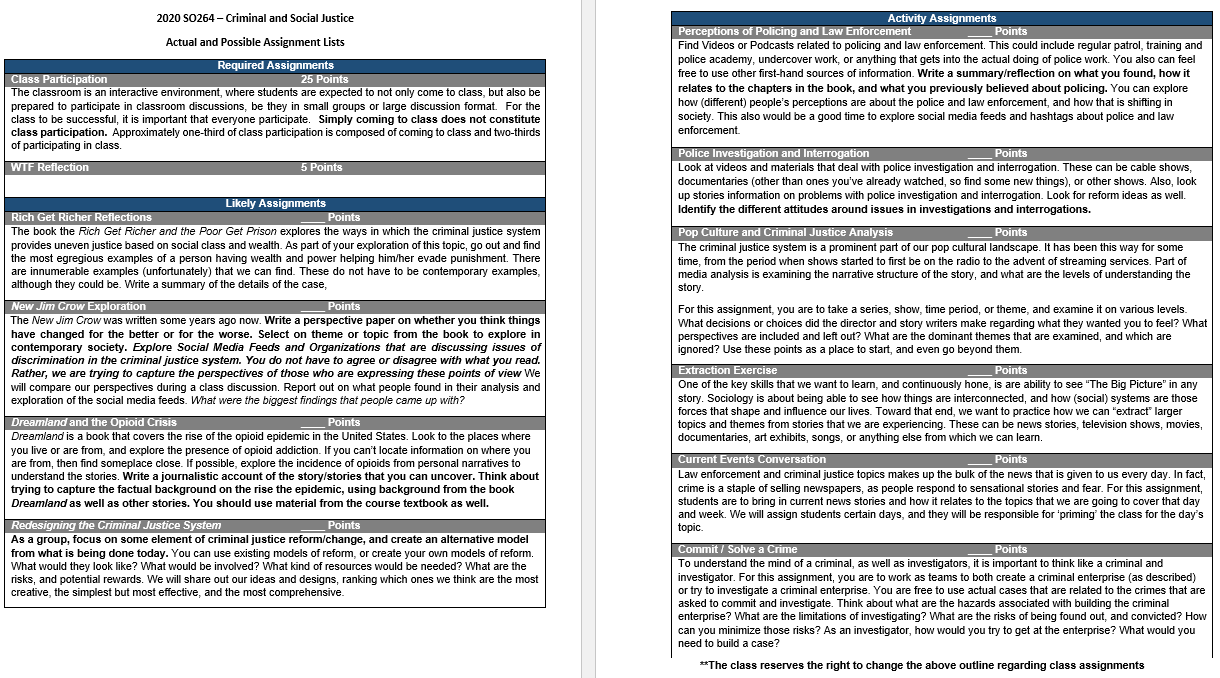Week 3 - Syllabus Completion, Assignment Creation, and the Paradox of Choice
There has been a lot of material coming my way about “this generation” and what they want from their educational experience. As a fun exercise, just do an Internet search for “students today” and see that comes up. Undoubtedly some of it is going to be useful and helpful. Not surprisingly, some of it is perhaps aspirational at best. One of the points repeatedly made is that “student of today” want more flexibility and personalization in their courses and programs. I am sure that students like the idea of flexibility and personalization. Hey, they can personalize their computer screens, phones, and everything else through online commerce. Why not personalize their education!
However, people who customize their computer desktops, or backpacks, or anything else, are just designing these things on their own. They often are selecting from options of personalization in which they can interject some of the own wants. For instance, even sites that allow you to design your own clothes do so with templates, guidelines, or instructions to follow. Website hosting companies that allow you to “design” your own site similarly ask customer to select from different options. It is not that you are building it from scratch, but that within a certain framework you have options to pick. It is a subtle, but important difference.
There is the saying that “too much choice is a bad thing.” A recent study, that has been making the rounds, confirms this point. The article “Choice overload reduces neural signatures of choice set value in dorsal striatum and anterior cingulate cortex” (you have to love academic titles) shows that “When choosing from sets of 6, 12 or 24 items, functional magnetic resonance imaging activity in the striatum and anterior cingulate cortex resembled an inverted U-shaped function of choice set size.” Exactly.
For a simplified translation, it turns out that when we get too far from around 8-15 choices of a product, we start to get overloaded. We know this from the book “The Paradox of Choice: Why More is Less” by Barry Schwartz. As the author states in the Preface, “I believe that many modern Americans are feeling less and less satisfied even as their freedom of choice expands….Instead, I believe that we make the most of our freedoms by learning to make good choices about the things that matter, while at the same time unburdening ourselves from too much concern about the things that don’t.” It is one things to ask a person “what do you want in a car?” That’s a big question that involves a lot of stuff that I might not care about. It is another thing to say “do you want the leather seats or cloth?” While there has been some question over whether this premise is accurate, to me it seems pretty straightforward: too many options coupled with a lack of information to evaluate them can be overwhelming.
This made me think of a few key points to consider in my course co-design perspectives. First, how much did students care about the course itself, and thus the choices that they made? The answer to such a question would be central to how motivated they’d be to design their own course and make their own choices. Second, what was their base knowledge from which they were making choices and design decisions? The students knew not much about the criminal justice system and sociology. They knew even less about course design. And knew probably less about learning evaluation and outcomes measurement. With this being the case, there was a limited framework from which they could draw to make decisions. Third, would then giving them more choice make them more miserable and stressed? If my goal was to get them involved in the design process, I could only do so to the extent that they wanted to get involved, and were capable of being involved. Only meeting twice a week for 90 minutes was not a lot of time to both design a course and take it.
Thus I decided I would have to short-cut some of the open-ended design options and start creating choices. As we moved into the assignment selection, curated my own thoughts in with elements of what they recommended, and created a type of menu of assignments from which they could choose.
While I gave the class the general structure, I gave them the opportunity to provide feedback on whether this framework made sense to them. There was general agreement that the Likely assignments made sense. However they thought that having a final project of some students trying to commit crime and some students trying to identify and stop crime would be fun. So we made the collective decision to move that assignment over in the Assignment category. The other ideas that they generated could serve to be in-class activities throughout the semester, versus being graded assignments.
Thus at the end of Week 3, we finally have a co-designed syllabus. It took much longer than walking in with one on the first day of the class. However, the dynamic thus far in the class has been more engagement and buy-in, especially from the graduating seniors.
However, a syllabus does not a class make. For a co-designed course, we need to secure continuous buy-in and engagement from the student. This will include the students actively providing content for other students to read and experience. It also will include students engaging in class discussion that results in their increased awareness of the course topics, fueled by their intellectual curiosity. These goals are much tougher lifts. It is a relatively easy exercise to have the students do fun activities in class for the purposes of generating ideas for a course. This in and of itself is a worthy activity. But ultimately, it should be a means to an ends. The larger goal, which we will be working on going forward, is to create an engaged class around an elective. To accomplish this goal, the course co-design process will need to continue beyond creating a syllabus.
To this point, we have been moving to this goal, but are not there yet. At the same time, we are closer than I believe we would have been if I just dropped a syllabus on their desks on Day 1.


